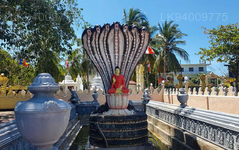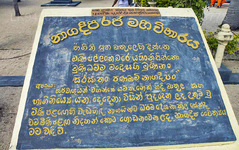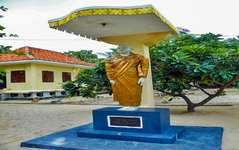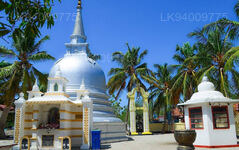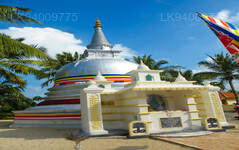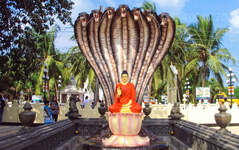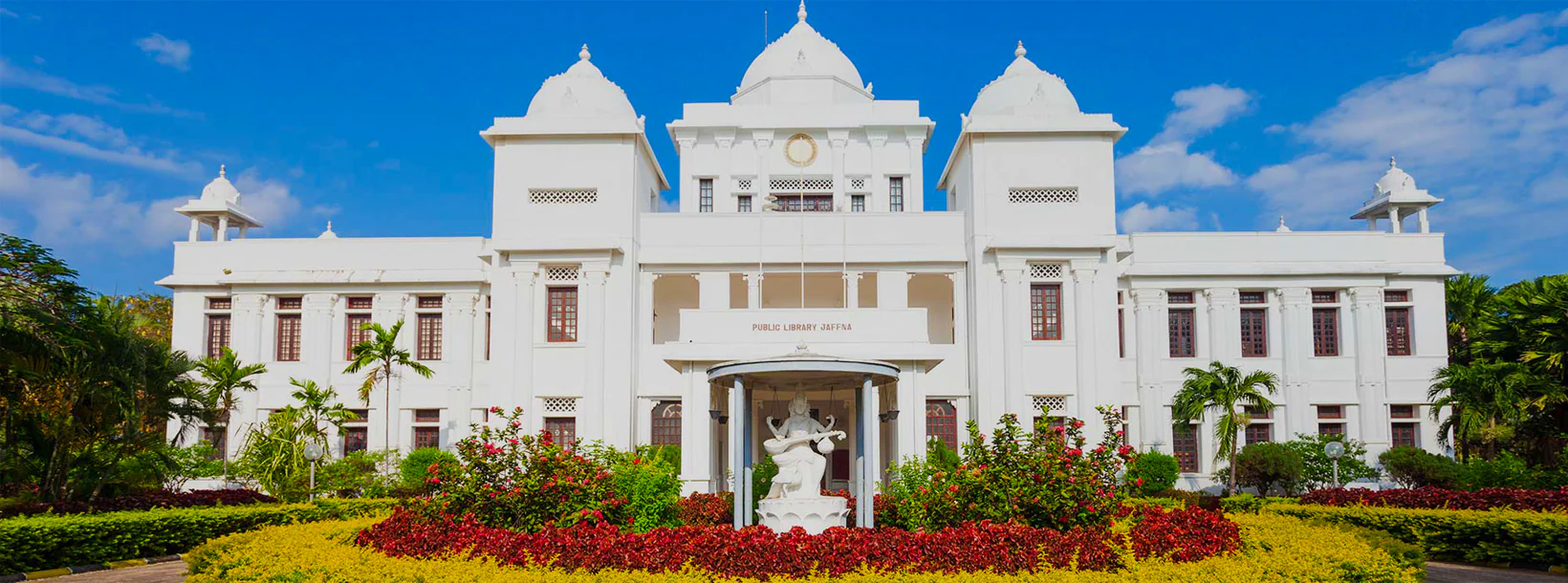
Jaffna City
Jaffna is the main city of Jaffna peninsula in the northernmost district of Sri Lanka. Comfortable intercity busses from Colombo take 10-12 hours to reach the city of Jaffna.
Nagadeepa Viharaya (නාගදීප විහාරය)
Nagadvipa liegt nur etwa 35 Meilen von Indien entfernt und ist die kleinste Insel im Golf von Mannar . Schon lange kommen Händler hierher und auf die umliegenden Inseln, um die Muschelschalen zu kaufen, die in den warmen, flachen Gewässern des Golfs geerntet werden. Die Muschelschale ist natürlich für bestimmte hinduistische und buddhistische Rituale unverzichtbar und ein besonders perfektes Exemplar einer nach rechts spiralförmigen Muschel kann einen enormen Preis erzielen. Seit dem 1. Jahrhundert n. Chr. kommen auch Pilger nach Nagadvipa (Nainativ), um die berühmte Stupa zu verehren. Im Mahavamsa ist die Insel einer der sechzehn heiligen Orte, und im tamilisch-buddhistischen Epos Manimekalai werden ein mit Edelsteinen besetzter Thron und ein Stein mit den Fußabdrücken Buddhas erwähnt, die in Nagadvipa aufbewahrt werden und zu deren Anbetung Pilger aus Indien früher kamen. Die Heldin des Epos wird als durch die „langen Sanddünen und Lagunen“ der Insel wandernd beschrieben.
Auf beiden Seiten des Seiteneingangs zum Tempel befinden sich jedoch zwei sehr alte Gegenstände. Auf der linken Seite, wenn Sie eintreten, befindet sich ein großer Stein mit einer Inschrift von Parakramabahu I. darauf. Im ersten Teil dieser Inschrift sagt der König, dass Ausländer, die ins Land kommen, nur in Uraturai (Kayts) einreisen sollten und dass ihnen bei Not geholfen werden sollte. Damit sind zweifellos Kaufleute und Pilger aus Indien gemeint. Im zweiten Teil heißt es, welche Maßnahmen zu ergreifen sind, wenn Schiffe mit Elefanten oder Pferden und Handelsschiffe Schiffbruch erleiden. Rechts vom Eingang befindet sich ein großer Stein in Form eines Lebensretters, ein alter Anker. Früher trugen arabische Schiffe solche Anker. Weniger als einen halben Kilometer die Straße hinunter vom Tempel entfernt befindet sich Nagadvipa Vihara, das den Ort markiert, an dem sich Buddha während seines Besuchs auf der kleinen Insel aufgehalten haben soll. Auf der einen Seite der Straße steht der Bodhi-Baum und auf der anderen die silberfarbene Stupa. Es gibt auch zwei Tempel, von denen einer ein bronzenes Buddhabild enthält, das 1956 von der burmesischen Regierung gestiftet wurde. Außer den Inschriften ist in Nagadvipa nichts von ästhetischem oder historischem Interesse; Alles wurde in den 1950er Jahren gebaut.
About Jaffna District
Jaffna is the capital city of the Northern Province, Sri Lanka. 85% of the populations of the Jaffna and Kilinochchi districts are Hindus. The Hindus follow the Saivite tradition. The remainders are largely Roman Catholics or Protestants, some of whom are descendants of colonial settlers, known as Burghers. The Tamils are divided along caste lines, with the farmer-caste Vellalar forming the majority. Sea products, red onion, and tobacco are the main products in Jaffna.
Jaffna is home to beautiful Hindu temples. An Old Dutch Fort still stands well preserved within which is an old Church. Another example of Dutch architecture is the King's House. No visit to Jaffna is complete without tasting the exquisite Jaffna mango, reputed for its sweetness. About 3 km away is the majestic Nallur Kandaswamy Temple, home to the largest religious festival in Jaffna. The Kayts Harbour is an ancient ship docking site in the Jaffna region.
About Northern Province
The Northern Province is one of the 9 provinces of Sri Lanka. The provinces have existed since the 19th century but they didn't have any legal status until 1987 when the 13th Amendment to the 1978 Constitution of Sri Lanka established provincial councils. Between 1988 and 2006 the province was temporarily merged with the Eastern Province to form the North-East Province. The capital of the province is Jaffna.
Northern Province is located in the north of Sri Lanka and is just 22 miles (35 km) from India. The province is surrounded by the Gulf of Mannar and Palk Bay to the west, Palk Strait to the north, the Bay of Bengal to the east and the Eastern, North Central and North Western provinces to the south.The province has a number of lagoons, the largest being Jaffna Lagoon, Nanthi Kadal, Chundikkulam Lagoon, Vadamarachchi Lagoon, Uppu Aru Lagoon, Kokkilai lagoon, Nai Aru Lagoon and Chalai Lagoon.Most of the islands around Sri Lanka are to be found to the west of the Northern Province. The largest islands are: Kayts, Neduntivu, Karaitivu, Pungudutivu and Mandativu.
The Northern Province's population was 1,311,776 in 2007. The majority of the populations are Sri Lankan Tamils, with a minority Sri Lankan Moor and Sinhalese population. Sri Lankan Tamil is the major language spoken in the province by the vast majority of the population. The other language spoken is Sinhala by 1 percent of the population. English is widely spoken and understood in the cities.

